The Best 5th Wheel Hitch For A Pickup Truck (Review)
The main difference between a 5th wheel camper and a travel trailer is the hitch. 5th wheel hitches are simple and easy to operate. They fit in the back of a pickup truck and reduce sway more effectively than a typical ball and coupler hitch.
Installing the right 5th wheel hitch is going to make your travels smoother, campground set up faster, and keep your trailer more secure.
In this article, we’re going to cover the different types of 5th wheel hitches, how to install them, and how to hitch and unhitch your camper.
- 20,000 lb GTW/5,000 lb VTW
- Fully articulating pivot head
- No mounting rails required
- 24,000 lb. GTW/6,000 lb. VTW
- Spherical axel pivot
- Coupling indicator
- Weighs just 35 lbs.
- 24,000 lb. GTW/4,500 lb. Tongue Weight
- 5-minute install
- Designed for short bed trucks
- 16,000 lb. GTW/5,000 lb. VTW
- Dual pivot
- Automatic locking feature
What Is A 5th Wheel Hitch?
5th wheels are unique campers. They’re designed to be attached to a truck bed rather than the rear bumper of a tow vehicle. Because of this attachment point, 5th wheels can be larger and heavier than traditional travel trailers.
The hitch plates are designed to pivot and absorb bumps along the road to making a smoother ride.
Single travelers can easily hitch and unhitch a 5th wheel trailer with no assistance. Once attached, they’re also easier to drive and maneuver than a travel trailer.
Most 5th wheel hitches are permanently installed in the truck bed. The heavy metal cylinder on the front of the trailer is called the king pin.
When you hitch up, the king pin aligns with the coupler on the receiving hitch. The two pieces are then locked into place, and you’re ready to drive.
Types Of 5th Wheel Hitches
Fifth wheel hitches all have the same basic function, but the design of the hitch makes some products quieter than others.
The main difference is how the king pin is held in place. If there’s any movement between the king pin and the coupler, you’re going to hear it loud and clear inside the cab.
Slide bar hitches are the least expensive. These are dependable, but they don’t secure the king pin as tightly as jaw hitches do. Slide bar hitches are extremely noisy and we wouldn’t recommend purchasing one unless you’re on a very low budget.
Double jaw hitches hold the king pin more tightly than slide bars. These are a good value because they’re moderately priced and relatively quiet.
Single jaw hitches are the quietest hitches on the market because the king pin is completely enveloped so there’s very little movement to be heard. These hitches give the smoothest ride, but they’re also the most expensive.
Gooseneck hitches are designed for 5th wheels that have a gooseneck adapter installed. Campers with a gooseneck adapter have a different weight distribution than regular 5th wheels. Gooseneck hitches are often lightweight and leave more space in the back of the pickup truck when you’re not towing.
Sliding hitches are designed for short bed trucks less than 8 feet long (not to be confused with slide bar hitches). Short bed trucks require you to place the hitch behind the axel of the tow vehicle so there’s enough clearance to make sharp turns. With a sliding hitch, you can line up the hitch right over the axel and the device will slide back on tight turns so the camper doesn’t hit the cab. These can be purchased as either manual sliding hitches or auto sliding hitches.
- Weight distribution hitches are designed for travel trailers to make the driving experience safer. They provide better friction and braking power for the tow vehicle, and reduce wear and tear on the trailer.
Single Pivot VS Double Pivot
All hitches allow a bit of sway to absorb bumps and impact while driving. Single-pivot hitches prevent front-to-back movement while double-pivot hitches prevent front-to-back and side-to-side movement.
Double-pivot hitches provide the smoothest driving experience, but they’re also more expensive then single-pivot hitches.
Weight Capacity
The single, most important thing you need to consider before purchasing a hitch is weight capacity. Not only do you need a hitch capable of towing your camper, but you also need a vehicle that can safely tow.
Making sure your pickup truck can tow a fifth wheel should not be a guessing game. Most 5th wheels are going to require a ¾ ton truck at a minimum.
Tow Vehicle Capacity
Start by finding the Gross Vehicle Weight Rating of the truck (GVWR). This can be found on a sticker inside the driver’s door or by doing an online VIN search.
Next, find the Dry weight of the trailer. This is found on a sticker located on the left, front (street side) of the vehicle. Then, add all trailer contents including passengers, cargo weight, and liquids to get the total trailer weight. The best way to figure this out is to get the trailer weighed, but you can calculate it on your own as well.
Finally, determine the Gross Combined Weight Rating (GCWR). This includes the trailer, tow vehicle, and all contents and passengers as you travel down the road.
RV Dry Weight + Passenger’s Weight + Cargo + Liquids + Tow Vehicle = GCWR
Total weight must not exceed towing capacity.
Alternatively, this tow guide calculator by Camping World allows you to enter your tow vehicle information and get an estimated towing capacity.
Hitch Capacity
First, determine the maximum weight of the 5th wheel trailer and all of its contents. Remember to include a safety margin in case you decide to pack extra liquids or passengers. At most, you should never exceed the Cargo Carrying Capacity (CCC) listed on the trailer.
On a fifth wheel, the tongue weight of the trailer should be about 10-15% of the total trailer weight; but we like to use 20% to give a safe margin of error. Remember, this number comes from the GVWR, not the dry weight.
For example: If your trailer has a total weight of 10,000 lbs. the hitch weight should be at least 2,000 lbs.
When comparing hitches, they will often list Gross Trailer Weight (GTW) and Vertical Trailer Weight (VTW). Generally, the higher the hitch capacity, the higher the price.
5th Wheel Hitch Installation
Installation of a fifth wheel hitch can get fairly involved and take anywhere from 60-90 minutes. You can expect to pay an installer between $75-$250 or do it yourself.
Fortunately, once the installation is completed most campers leave the hitch permanently attached so you only need to go through the process once. This video by Curt Manufacturing is a good example of how to install a 5th wheel hitch.
Hitch Rail Installation
The hitch rails get installed in the truck bed frame, centered directly over the rear axel–or slightly forward. In a short bed truck (under 8 feet) you’ll need to place the hitch slightly behind the axel or use a sliding hitch. You should always install the hitch directly on the metal bed, not on a plastic bed liner because it can disintegrate over time.
Align the front base rail closest to the cab, with the back rail towards the tailgate. Mark the drill locations and create a pilot hole. Check the bracket alignment under the bed; if everything aligns correctly, continue with the remaining bolt holes.
Once the holes have been drilled and widened to accept each of the bolts, paint the bare metal to prevent corrosion.
Finally, bolt the under bed brackets and the fifth wheel rail.
Hitch Install
After the rails have been installed, it’s time to attach the hitch. To do this, you’ll need to find the correct hitch height. There should be 5-6 inches of clearance between the trailer and the truck bed walls.
Start by parking your camper on an even surface and measuring from the ground to the base of the king pin. Then, measure from the ground to the top of the truck bed with the tailgate open. The difference will give you the hitch height needed. If the truck is too tall for the trailer, you may need to do suspension modifications.
Adjust the hitch legs to the most appropriate height. Then attach the legs to the base rails and bolt any remaining components.
How To Hitch A 5th Wheel Camper
The best part about owning a 5th wheel instead of a travel trailer is that hitching is easier. This process can be done by an individual with no spot partner–although it does make things faster.
- Start with a camper that is parked on a level ground with the wheels chocked to prevent movement.
- Loosen the front landing gear, and make sure the rear landing gear is up.
- Lower the tailgate of the truck and slowly back up until the king pin is close to the hitch coupler.
- Stop, and open the hitch locking mechanism.
- Raise the front landing gear so the king pin is positioned even with, or slightly below the coupler.
- Slowly back up the truck until the king pin is aligned and fully engaged with the coupler jaws. The handle will close automatically if it’s correctly aligned.
- Park the truck and set the emergency brake.
- Close the locking bar and safety latch.
- Connect the trailer light cord and breakaway switch lanyard to the tow vehicle.
- Raise the front landing gear until they are about 1-inch off the ground and slowly drive forward to conduct a pull test.
- Fully retract the landing gear and remove wheel chocks.
- Close the tailgate.
- Test your camper brake lights and turn signals.
- Store the wheel chocks, trailer jacks, and any outdoor campground equipment.
How To Unhitch A 5th Wheel
As you can imagine, unhitching a fifth wheel follows the same steps as hitching but in reverse order.
- Start by parking your camper and tow vehicle on a level surface.
- Use wheel chocks to prevent the camper from rolling out of place.
- Lower the 5th wheel landing gear.
- Lower the tailgate.
- Disconnect the trailer light cord and breakaway lanyard.
- Raise the trailer jacks until there is space between the king pin and the hitch plate.
- Open the safety latch and locking bar. You may need to put the truck in gear if there is too much pressure on the king pin and you’re unable to open the safety latch.
- Slowly drive the pickup forward.
- Finish by leveling the camper using the front landing gear.
If the fifth wheel hitch will not release, try lowering the landing gear further to raise the king pin higher above the hitch plate. The idea is to get all of the weight off the pin box.
If you’re still having trouble, release the emergency brake on the tow vehicle and place it in neutral to release pressure. Then put your truck back into park and release the lock handle.
The Best Fifth Wheel Hitches Reviewed
- 20,000 lb GTW/5,000 lb VTW
- Fully articulating pivot head
- No mounting rails required
Top Choice: B&W Companion 5th Wheel Hitch
One of our favorite hitches on the market is the B&W Companion. We like this hitch because of its versatility and convenience. The under-bed mounting style allows you to tow a standard fifth wheel or a gooseneck hitch with the same system. That means if you decide to upgrade your 5th wheel to a gooseneck style later, you can continue to use the same hitch.
This hitch is also unique because no rails are necessary. The lack of rails makes it easier to install and leaves more space in the truck bed for gear. You can add and remove the hitch faster when it comes time to pack away your camper for the winter. The B&W Companion also has lifetime coverage which is comforting for such a large purchase.
- 20,000 lb GTW/5,000 lb VTW
- Fully articulating pivot head
- No mounting rails required
- Limited lifetime coverage
- 24,000 lb. GTW/6,000 lb. VTW
- Spherical axel pivot
- Coupling indicator
Best Value: CURT 5th Wheel Hitch
CURT Manufacturing has always been a top-rated brand when it comes to high-quality gear. Their quiet-ride 5th wheel hitch is a great value because of its huge tow capacity for a reasonable price. This hitch has been engineered to function as quiet as possible using a spherical axel bearing to tilt in any direction.
Another cool feature is the build-in coupling indicator which can show you whether the hitch is coupled, uncoupled, or ready to tow without having to guess. The short-throw handle is also lockable for extra security on the road.
One thing to keep in mind with this curt hitch is the base rails and brackets are sold separately.
- 24,000 lb. GTW/6,000 lb. VTW
- Spherical axel pivot
- Coupling indicator
- Weighs just 35 lbs.
- 24,000 lb. GTW/4,500 lb. Tongue Weight
- 5-minute install
Best For Gooseneck Trailers: Anderson 5th Wheel Hitch
If your 5th wheel has a gooseneck hitch, the Anderson 5th wheel hitch is our top choice for consideration. We like the Anderson hitch because it’s extremely lightweight at just 35 pounds. The greaseless coupler makes for an extremely smooth ride so you won’t have to hear rattling or feel every bump in the road.
This hitch is designed to be mounted and removed by one person in under 5 minutes so you can use it for the camping trip, then store it away when you’re done. That leaves the whole truck bed available for gear storage.
- Weighs just 35 lbs.
- 24,000 lb. GTW/4,500 lb. Tongue Weight
- 5-minute install
- Designed for short bed trucks
- 16,000 lb. GTW/5,000 lb. VTW
- Dual pivot
- Automatic locking feature
Best For Short Bed Trucks: Curt Sliding Hitch
Short bed trucks require a sliding hitch so you can avoid the mistake of making tight turns that force your trailer to impact the cab. The slider hitch from CURT Manufacturing is our favorite product because it mounts on standardized 5th wheel rails and brackets plus it has an additional 12-inches of travel.
This hitch has a dual-pivot head, automatic locking, and an anti-rattle feature to minimize vibration and provide a smooth ride. The base rails and brackets are sold separately.
- Designed for short bed trucks
- 16,000 lb. GTW/5,000 lb. VTW
- Dual pivot
- Automatic locking feature
That’s A Wrap!
There’s a lot to think about when choosing a hitch for your camper. Fifth wheels provide a smoother driving experience, allow for larger rigs, and are easier to hitch and unhitch than a traditional trailer so there are a lot of benefits to owning one.
If you’re looking for the best overall hitch, we recommend the B&W Companion or CURT Manufacturing hitch. With a gooseneck adaptor, you can’t go wrong with the Anderson hitch which is lightweight and easy to install.
Shortbed trucks require a sliding hitch, and for that, we recommend this hitch from CURT Manufacturing.

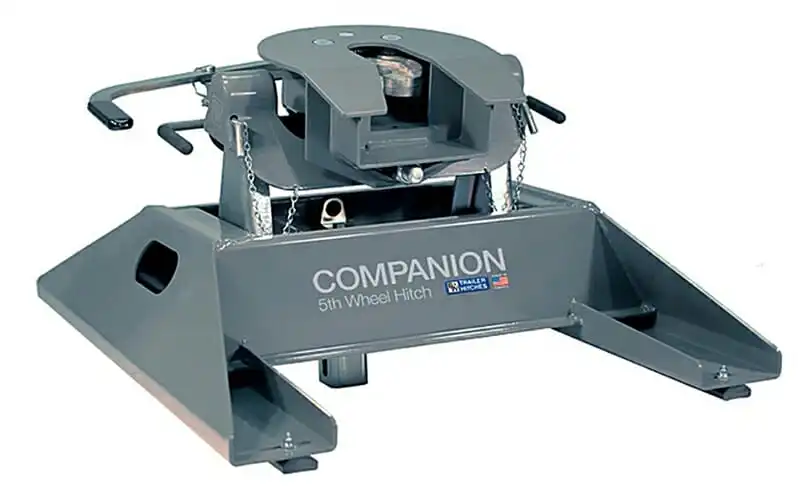
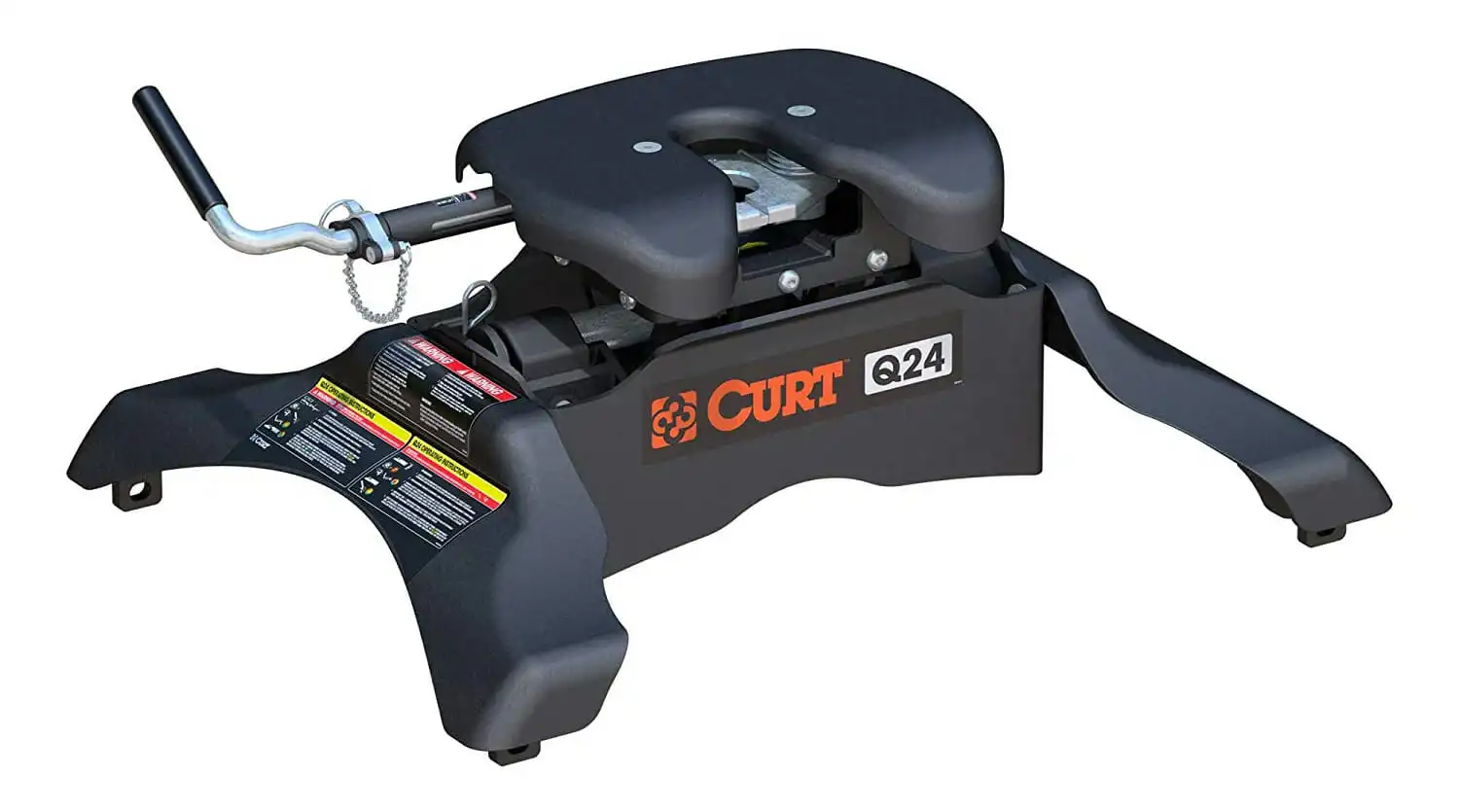
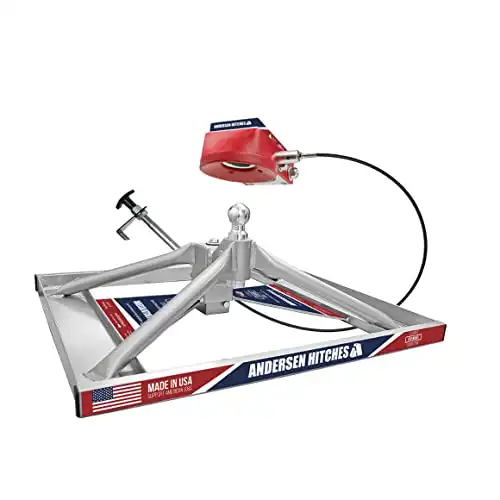
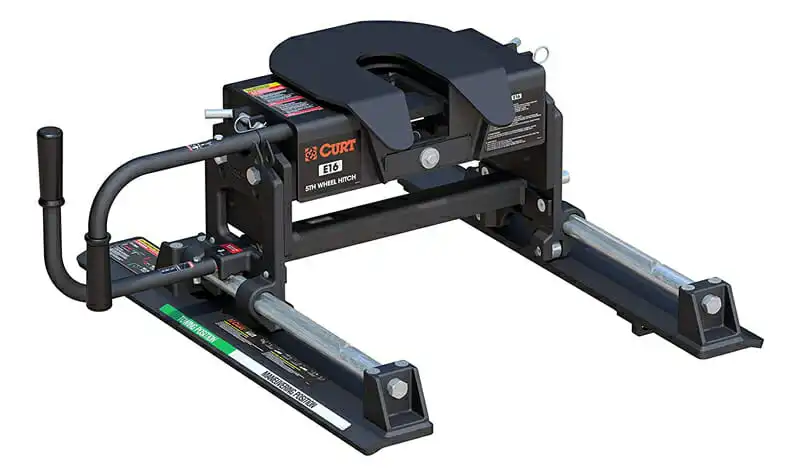
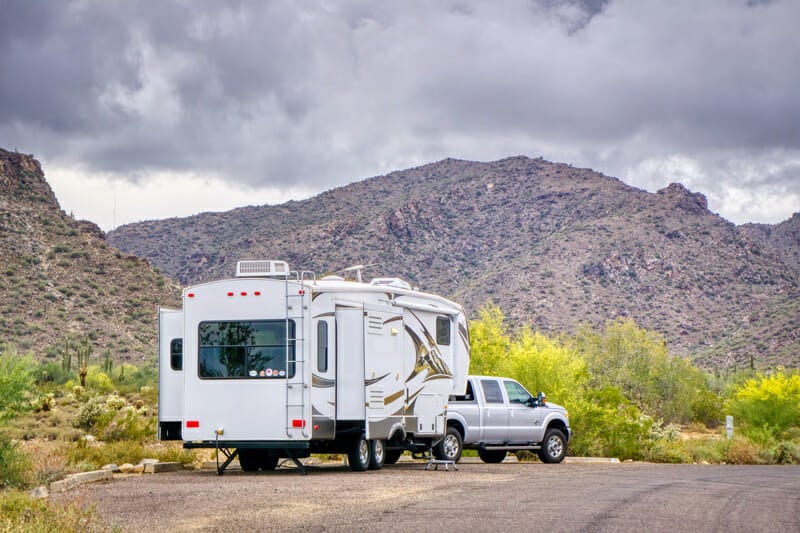
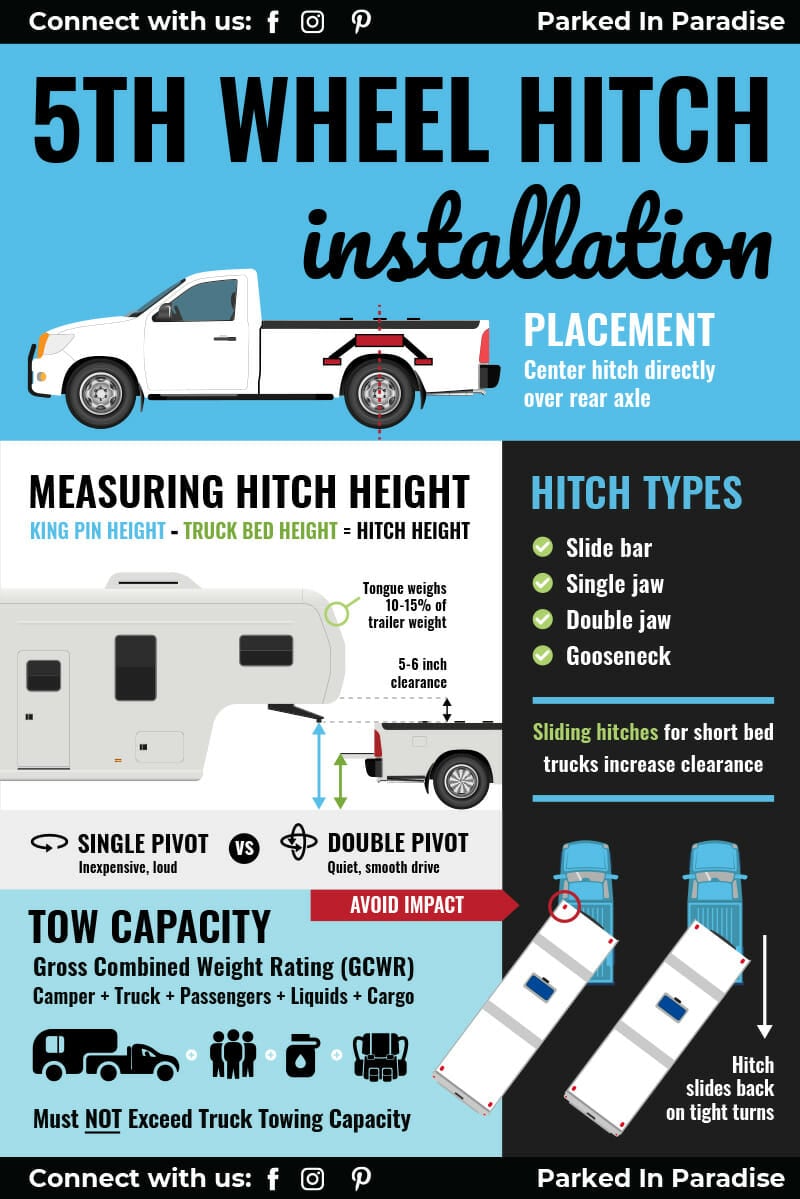
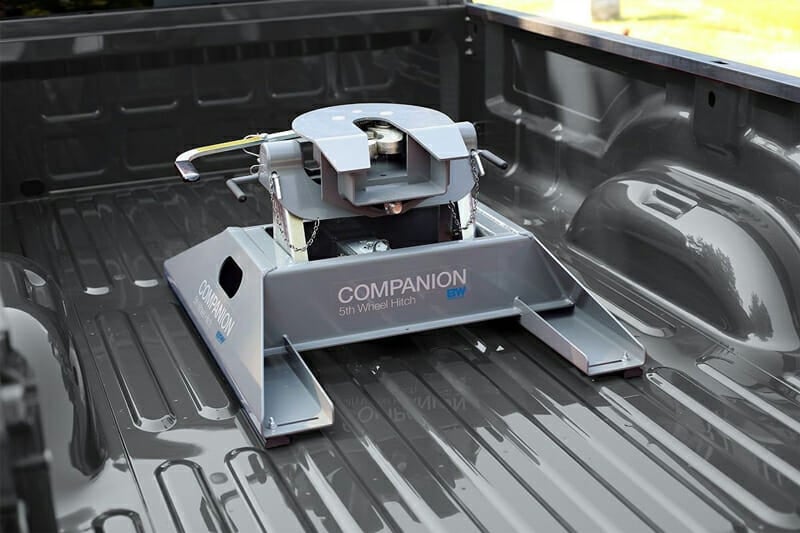
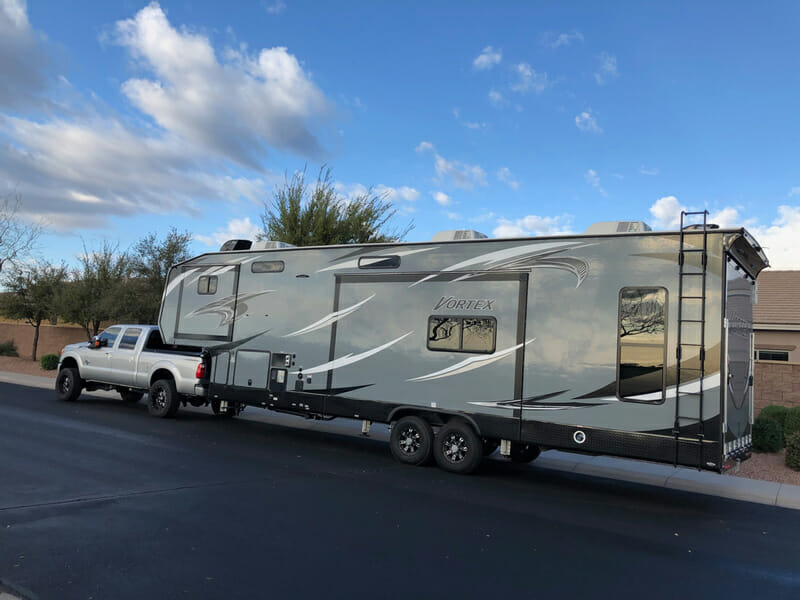
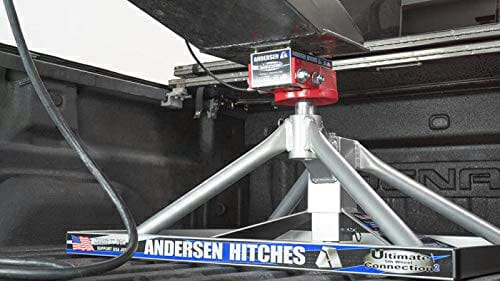
Should include the pullrite super lite in this group. Very easy to install, lite and 20k capacity.
Really need to add the two gooseneck replacements, reese goose box and the Gen Y. More expensive but only a goose ball to store. And totally open truck bed.
You could have mentioned there is a Sidewinder style King Pin in which the King Pin is locked and wedged so it will not turn. There is a turret behind the king pin so your turning point is not over the truck’s rear axle. I got rid of my slider rails and switched to the Sidewinder this gave me an additional 10 inches in the moment arm. I can now turn a true 90 degrees with no fear of hitting the back of my truck. With a slider I could not turn that far plus I had my round slider jam on me a few times.
You have axle spelled correctly and incorrectly in this article. You may want to edit that.
Not one air hitch reviewed in the story.